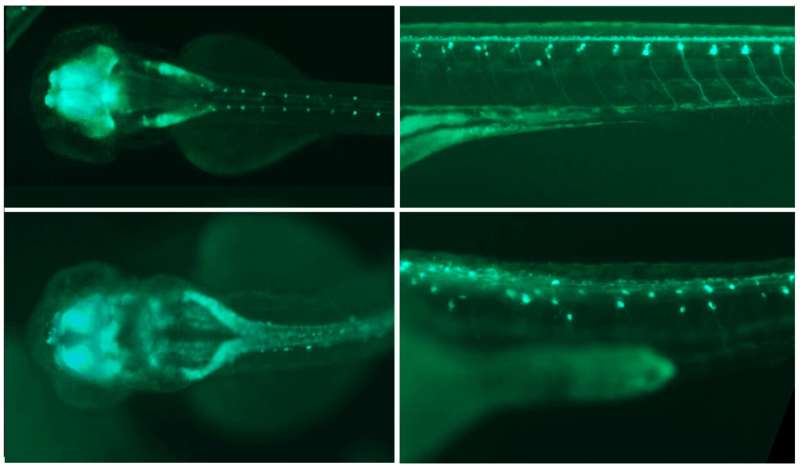Gene plays major role in brain development

The so-called Plexin-A1 gene seems to play a more extensive role in brain development than previously assumed. This is shown by a current study led by the University Hospital Bonn and the Institute of Anatomy of the University of Bonn with more than 60 international partners. The gene is also interesting for another reason: Its mutations are inherited either dominantly or recessively, depending on which part of the gene is affected. The results of the study are now published in the journal Genetics in Medicine.
When the Augustinian monk Gregor Mendel crossed white-flowering with purple-flowering pea plants in the mid-19th century, he made an interesting discovery: The offspring were all purple. He therefore called this trait dominant, while the white blossom color was recessive. The reason for this phenomenon: In peas, each gene occurs twice. One version comes from the maternal plant and the other from the paternal plant. If a pea has inherited the gene for purple flower color from one parent, but the gene for white flower color from the other, purple wins. Only when two genes for white flowers come together in the offspring plant is it white.
Humans also have genes that are inherited either dominantly or recessively. However, the case is not so clear for the mutations investigated in the study: Some of them are dominant, meaning that a mutation inherited either by the mother or by the father is sufficient for the mutation to have an impact. Others, however, are recessive. "This has also been observed sporadically with other genes, but it was still unexpected," explains Dr. Gabriel Dworschak, pediatrician at the University Children's Hospital who conducted his research at the Institute of Anatomy and the Institute of Human Genetics.
Malformations of the brain and eyes
The gene came into the focus of the researchers when they examined a girl with severe malformations of the esophagus, brain and eyes at University Hospital Bonn. A genetic analysis revealed that her Plexin-A1 gene was different from that of healthy individuals. "We then searched a database for other affected individuals with mutations in the plexin gene," explains Prof. Dr. Heiko Reutter, physician at the University Children's Hospital and staff member at the Institute of Human Genetics at the University of Bonn.
The researchers have now found a total of ten patients in this way; they come from seven families. "The affected individuals all had different parts of the Plexin-A1 gene altered," Dworschak points out. "Five of these mutations are inherited recessively; the remaining three are dominant." Further analysis helped the researchers understand why this is the case: The Plexin-A1 gene contains the building instructions for a receptor. It is located in the membrane that surrounds the nerve cells like a thin skin. Certain messenger molecules can dock onto its outer surface. This then triggers a response at the other end of the receptor that protrudes into the cell.
"If a mutation affects the outside of the receptor, it can no longer receive signals," speculates Dworschak. "However, if only one of the two Plexin-A1 versions is affected, there are enough intact receptors to compensate." Mutations on the outside are therefore probably recessive. A defect on the inside of the receptor, however, can result in a serious misregulation of the cell. It may be enough for only one version of the Plexin-A1 gene to be altered in this way to cause significant damage. "We therefore think that such mutations are dominant, and we then speak of a dominant-negative effect," says Dworschak.
Different symptoms
Overall, affected individuals show a wide range of symptoms. What they all have in common, however, is that their brain development is disrupted to varying degrees. Many of them also have malformations of the eyes and skin. "It was known that the Plexin-A1 gene is important in the growth of nerve cell extensions," Reutter explains. "Nerve sprouting plays an essential role in the development of many organs. The observed malformations in affected individuals could therefore be caused by the disrupted development of certain nerve fibers." A follow-up study at the Institute of Anatomy is currently investigating this question.
The Plexin-A1 gene performs an important function not only in us, as studies on a completely different species show. The researchers used the expertise of the working group led by Prof. Dr. Benjamin Odermatt from the Section of Neuroanatomy. The zebrafish serves as a model organism here—not only because it is easy to keep in terms of animal welfare requirements and can be bred quickly, but also because many of its genes are found in a similar form in humans. This includes the Plexin-A1 gene.
"If we switch off this gene in zebrafish, brain development disorders similar to those in humans appear," Dworschak explains. He hopes that the results of the study will help researchers to better understand the complex processes involved in brain development.
More information: Gabriel C. Dworschak et al, Biallelic and monoallelic variants in PLXNA1 are implicated in a novel neurodevelopmental disorder with variable cerebral and eye anomalies, Genetics in Medicine (2021). DOI: 10.1038/s41436-021-01196-9





















